Ultimate learning guide for early chess beginners
Chess is one of the most complicated board games out there, there are so many intricacies that work together that one can easily fizzle out from all the knowledge.
This is why I have the urge to really help as many beginners as I can by providing all the readily available information on this blog, I think it’s time for me to talk on this topic.
There are so many minor things about chess that is bigger than it sounds. One is how different it is to play the two colors (white and black), another example are the different ways to draw in chess.
If you are an absolute beginner with no prior understanding of chess whatsoever, how do you get started with chess? It looks hard, but it can be done.
This guide will not only tell you what to do, but also tell you in what order to do them. For early beginners this important in order to learn the basics of chess. This will help you properly apply the concepts correctly throughout the learning process.
This will also allow you to learn things in an appropriate order so you don’t get confused with many complicated concepts that you can pick up later on, I think this will work fantastic.
With all of that in mind, let’s begin.
1.) Comprehend why the piece colors are important
Upon starting with chess you will learn that there are two colors available for playing, white and black.
Both colors will have an intrinsic advantage/disadvantage that is unique from one another, this will be an important aspect if you were ever to play chess.
At the surface level it may seem simple, white will move first and black will move second, therefore white will have a slight advantage over black.
That is true if we’re talking at a professional level where every individual advantage matters, in low-rated to mid-rated level black can actually have some unique advantages on its own.
As a general rule here are the advantages of white:
- Lines with white usually will have more space.
- White having the first move, will naturally achieve the objectives in the opening match faster.
- There are more traps with white than black.
- It’s easier to play aggressively with white than black.
White doesn’t get all the fruits in the world, here are the advantages of black:
- Openings made by black are less predictable.
- It is easier to deviate from a well-known opening with black than white.
- Black has much more opening theories (more lines to study from).
- There is less pressure to convert a win unlike if you were playing with white.
- A draw with black in an armageddon game is already considered a win.
I think you should learn this right from the start to make it easier to incorporate all the knowledge later on when you are compiling the ideas.
2.) Learn what is a checkmate
A checkmate is a condition that a player can put to an enemy king in order to win a game of chess, basically a state where the enemy king will unstoppably be captured next turn.
That is actually the objective in a game of chess, you either win by delivering a checkmate or the opponent resigning since the checkmate will eventually be conceived.
As an early beginner this is one of the basic, but the most important aspect you can learn in chess, a checkmate is the objective of all objectives.
You will use your own pieces to deliver a checkmate against the opponent king, you must accomplish this by putting the enemy king in a state for it cannot move, block, or capture pieces that would let it escape.
Once that there is an attack that the king cannot absolutely survive from using a legal move in the game then the checkmate is fully achieved.
This is also the reason why a player can’t technically capture the king in chess, it can only be put in a checkmate where the game will just end without the king being visibly captured.
3.) Understand how checks work
A check is basically threatening a player’s king for capture, every piece or pawn who is threatening to capture the king is considered to be delivering a check.
This is important since when a check is made it has to be appropriately responded to by moving the king, blocking the check, or capturing the checking piece (since a player cannot afford to lose the king).
If a king somehow chooses another move during a check instead of moving, blocking, or capturing the checking piece then it is considered illegal, there are also other rules that go around this idea.
Some would say that it is required to say a check whenever a check is made, but this is actually not true.
It’s one of the fundamental concepts you can learn in chess since a check usually comes first before a checkmate.
4.) Learn how the pawn and pieces move
This is one of the most complicated aspect that makes chess difficult to learn, which is getting a natural feel of the pawn/pieces’ unique movements.
It is natural to feel lost from memorizing movements from six different pieces that are special in their own right.
But for starters here are the movements of the chess pieces in chess:
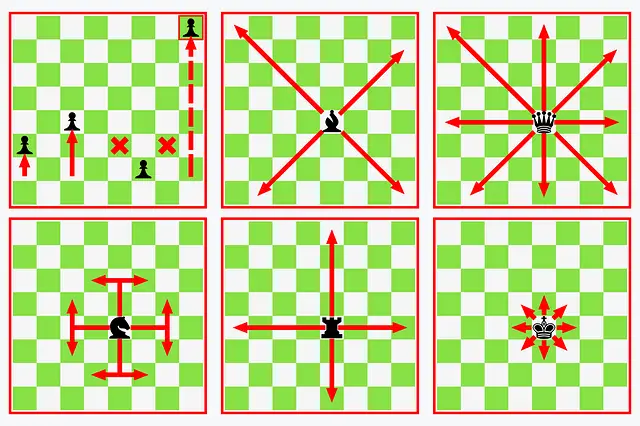
The pawn moves up the board from the way they are facing and can only go forward never backward, it can only switch the file that it is going to when it captures diagonally.
And yes, the pawn does capture one tile diagonally and not forward, it can also move two spaces forward on its first move but will lose the ability later on.
The rook can move in any straight line going horizontally or vertically and can also capture this way, it has no limitations to how many times it can go horizontally/vertically.
The knight can move in any l-shaped direction going forward, backward, or the sides. The bishop in any direction diagonally of its own color, and the queen in any direction vertically, horizontally, and diagonally.
5.) Learn how the chessboard is setup
A beginner should learn how to set up the pieces on the board since well, they will have to do it if they were to play chess.
And learning the starting position will give you an idea of how to incorporate the movement of the pieces/pawns to the objectives of the game.
For that I will take a quick photo to easily show some demonstration on my own chess board:
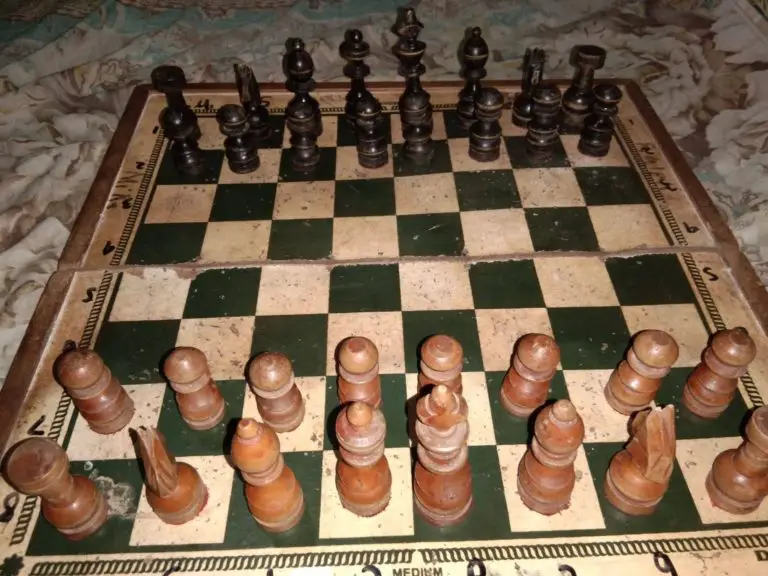
As you can see the pawns are in front of every other piece and have been placed side by side, this is the starting position for the pawns.
The rooks are placed into its corners of the board far left and right then the knight, the bishop, and the notorious queen and king.
I say notorious since a lot of beginners will mix up the position of queen and king and sometimes don’t even know where to place them (even though they are decent in the game).
Always remember that the queen is placed on the same color as the player (for example white queen will always be on a white tile), and the king should always be placed in the opposite color of the player’s color (for example the white king will always be on a dark tile).
This opposite will be the same for the opponent no matter the color, and in fact, it will be the same for every other piece or pawns.
The starting position in chess follows a sort of a symmetry, where both sides are mirroring the position of one another.
This will always be the starting position in chess no matter the time or tournament format, it will never change and should stay the same.
6.) Grasp the concept of castling
Castling is a special rule in chess where the king and rook (not moved previously) can choose to consolidate their position by having the king move in a sort of two steps into the corner primarily to keep the king safe.
There are actually two types of castling, short and long.
The short castling is performed by the king side group and the king in order to achieve this position:
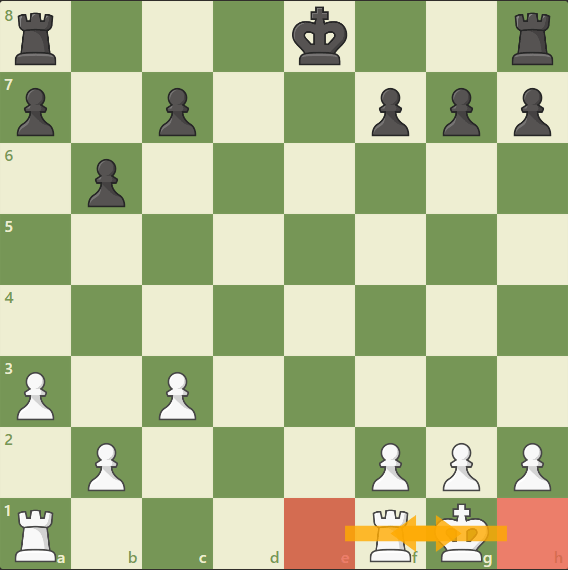
The king originally resides in e1 and the rook on h1 where they have performed a short castle in order to reach this position.
This is the only special rule in chess that allows movement from two pieces at the same time, the king on a short castle, in particular, is one tile away from the corner of the board.
There is another type of castling known as a long castle or queen-side castle that will reach this position:
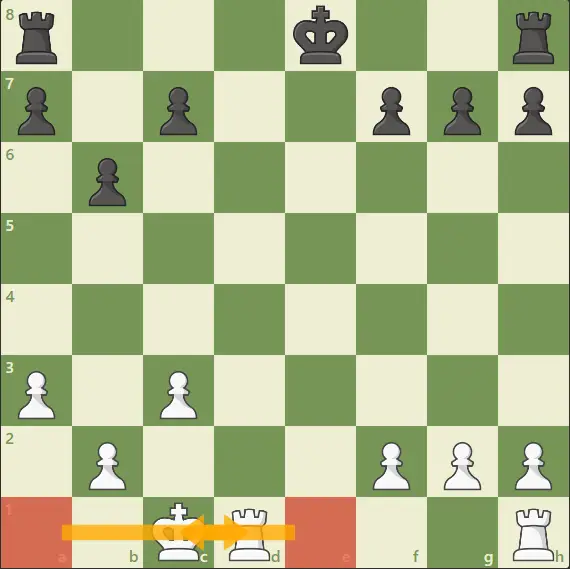
The king originally resides at e1 and the rook on a1 before achieving this position. It is a little bit different from a kingside castle since it is somewhat long (therefore the name long castle) where the king is two tiles away from the corner (unlike with one).
Both castles will have their own individual advantages and disadvantages which I have discussed in detail here (will open in a new tab).
A player cannot castle when:
- There is a piece/pawn in the way between the king and the chosen rook to be castled with.
- The path of the king leading to a castle is covered by an enemy piece.
- The king or the chosen rook was moved before.
Both sides are capable of castling and are not only available to a particular color, and there aren’t any number of moves that will incapable a player from castling.
7.) Know the nature of pawn promote
Whenever a pawn reaches the opponent’s last rank (where the pieces reside at the start of the game), they can be converted into another valuable piece. It can range from the queen, the bishop, the knight, and the rook with the exception of the king and pawn:
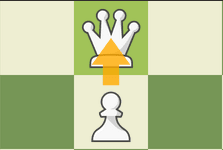
The pawn can of course never be promoted into another king since there can only be one (the most valuable piece in the game) and the target should not be separated. And it cannot remain a pawn since it will just be useless there.
If a pawn can choose to remain as a pawn it wouldn’t really result in a significant advantage for the player, in fact, it can be detrimental since it couldn’t even move forward (pawns can only move forward).
The most common piece to be chosen for a pawn promotion is actually the queen since it is the most powerful, on rare occasions it can be a knight if there is a benefit in doing so.
The queen is so common in pawn promotion that it earned a term for itself, named queening (since most promotions result in a queen more than any other piece).
There really is no advantage whatsoever in bringing a rook or bishop since the queen is basically a combination of those but is much stronger, something that has the strength of both.
The knight will of course occasionally be brought out since the queen cannot move like the knight.
If the queen is able to move like a knight then and knight might become an irrelevant pawn promotion choice, this is proof that the queen in most cases is really the best option.
8.) Grasp how en passant works
En passant is something that a lot of beginners usually slip by from learning all the basic ideas, but it definitely occurs within the game much more often than you think.
An en-passant capture can occur when a player chooses to use the initial two tile movement of the pawn while a corresponding enemy pawn is right beside it, in this case the enemy pawn can capture the moved pawn even if they are just placed side-by-side not diagonally:
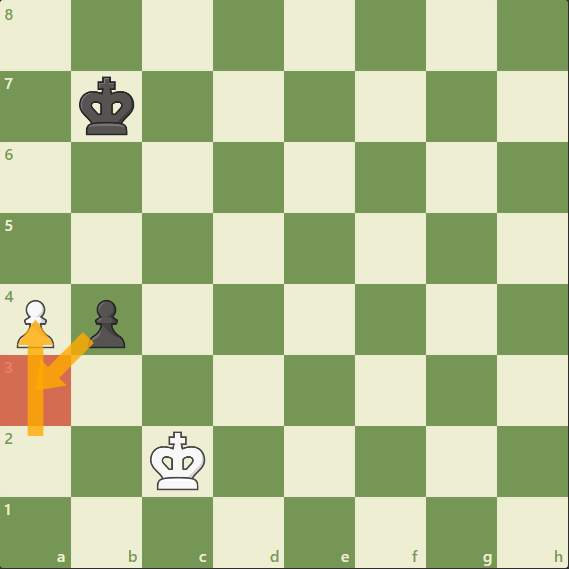
In this example white just moved his pawn from a2 to a4 while there is an enemy pawn right at b4, in this case since the white pawn has moved two tiles while there is a black pawn on the side, the black pawn can capture and land on a3.
And this is exactly what en passant is and can apply throughout the game from early in the opening and late into the endgame, as long as the captured pawn was moved two tiled ahead.
A player cannot execute an en passant capture if the to-be captured pawn has only moved one tile at the time, it has to be two tiles. This would apply both in competitive and informal settings since it is intrinsically included in the laws of chess.
9.) Recognize the touch-move rule
The touch-move rule states that a player that has already touched a piece or pawn should be required to move that piece or pawn as long as there is a legal move available.
This is to prevent players from touching their pieces over and over again in an annoying manner and being indecisive on which move to play, once you have touched something you have to commit to making a move with it.
It doesn’t matter that all the available moves will result in the loss of the game as long as there is a legal move, so you should be careful whenever touching a piece.
This would apply both in competitive and informal conditions unless there is a prearranged rule that both players agree with (in an informal setting).
If there is no available legal move then the player should choose to move another piece that has a legal move (the touch-move rule does not apply).
In informal settings there should be no penalty in touching a piece that has no available moves and in competitions it can be a bit blurry, faster time controls will usually have a penalty on this but longer format usually doesn’t.
And it seemed to also depend on the federation the tournament was organized in, some federations will have a special condition about this touch-move rule so you should check on that.
But as far as we are concerned the touch-move rule does exist in a wide spectrum of settings.
10.) Study basic theoretical values
Theoretical values in chess are basically how much each piece is worth when compared with one another, the idea being that you should evaluate which pieces are more important when making trades.
For example if you can trade a knight for a rook would you do it? Objectively you are making a theoretical value in your head when making this decision, on which is actually more valuable: the knight or the rook?
This is important on the basic level if you are to play a full game of chess (since you will be making trades) in order for you to keep the stronger pieces and trade the weaker pieces for it.
Now there could be a whole debate about all of this which I made an article here (will open in a new tab) but I will just summarize it.
There are two primary ideas in the theoretical value of the pieces, the one below is the most common and what a lot of players follow which actually has a name, Reinfeld values:
| Chess Piece | Theoretical Value |
| King | Infinite |
| Queen | 9 |
| Rook | 5 |
| Bishop | 3 |
| Knight | 3 |
| Pawn | 1 |
Fundamentally a lot of experts agree that this model will be useful for beginners than many other, however if you’re looking for a more advanced one then Bobby Fischer’s model is good for you:
| Chess Piece | Theoretical value |
| King | — |
| Queen | 9 |
| Rook | 5 |
| Bishop | 3.025 |
| Knight | 3 |
| Pawn | 1 |
This is basically the same as the Reinfeld value with the exception that the bishop is a little bit higher on the priority scale than the knight, this will fit advanced players more (since bishops are favored strongly than the knights in the endgame).
This is just the basic theoretical value, trading one piece over another can easily make you decide which piece is more valuable.
However if a combination of pieces is what’s on the table, a queen for a rook and knight for example, things become a little bit complicated.
However you can still use the value above (queen=9, rook=5 and knight=3, a total of 8) to evaluate that the queen is much more valuable than one rook and a knight (9 is more than 8).
However it is much more complicated than that (it depends on the position) but as a beginner, this will work just fine for you.
11.) Determine how chess time formats work
In chess players are required to play under a specific time control, this is to equal out the thinking time allotted for both players to come up with their moves.
After all, one can take a really long time to think about every individual move while the other can move fast with less thought, this will make it more likely for the player who takes a long time to win even if they are not better in skill.
There should be an incentive in place to reward those who are able to think quickly yet not lose easily, this is the purpose of time controls that will subject both players in a time pressure to force them in making the moves in a limited time.
There are different time formats in chess namely bullet, blitz, rapid, and classical, there are also other outliers such as correspondence. But really, the only formats that matter in competitive settings are the first four (bullet, blitz, rapid, and classical).
There are many variations to how many minutes are given in each individual time formats but should range in the following
| Time format | Total time |
| Bullet | 1+0 |
| Blitz | 5+0 (or 3+2) |
| Rapid | 10+0 (or 10+3) |
| Classical | 15+ (and beyond) |
The first number represents the minutes given for each player, and the number at a plus is the increment (in seconds) given on each move. A 3+2 for example is 3 minutes for each player and added two seconds for each individual move.
This meant that the duration of the game is not really a total of 6 minutes (3 minutes per player) since there will be added time after every move.
Other variants such as correspondence can last for days but is not really the primal format in competitions, for the most part it is all about bullet, blitz, rapid, and classical.
12.) Study reading/writing chess notations
Chess notations are a way to communicate the moves and position of the pieces on a chessboard even without visually looking at the board, it is the language of chess.
Each piece will have a designated letter that corresponds with the particular file and rank in order to tell a position, along with certain additions in order to show the movements. Here is the general rule of reading and writing chess notations:
- King = K, Queen = Q, Bishop = B, Knight = N, Rook = R, Pawn = no notation.
- Capturing an enemy piece sees an “x” placed between the piece moved and the square the captured piece was upon.
- When the opponent’s king is threatened by check, a “+” sign is added to the end of the notation.
- Castling kingside is written as “0-0”. Castling queenside is notated with “0-0-0”.
Here is a chessboard with simple chess notation on the side, as you can see there are a bunch of numbers and letters embedded on the bottom and the right of the chessboard:
This is actually how to tell the position of the pieces from which you would combine the letter and the number to arrive at a particular tile. This the general rule:
- From left-to-right from White’s perspective, the squares are ordered alphabetically with letters from “a” through to “h”.
- From Black’s point of view, the squares are in reverse alphabetical order – Black’s left-most squares are “h” squares, and Black’s right-most squares are “a” squares.
- Each square also gets a unique number, from “1” to “8”. The rank closest to the White player in the initial setup are “1” squares, the next rank the “2” squares and so on… to the rank closest to Black, which are “8” squares.

Let’s give an example, there is a knight in the middle of the board which is in the “d” file (vertically) and “4” rank (horizontally), if you read this from the basis above the symbol of the knight is actually “k”, making the position of the knight Kd4.
If that same knight were to capture the pawn on f5, the pawn has no symbol and it is on the f (vertically) and 5 (horizontally), then you would put an x between them making it kxf5, or would be read as knight captures f5.
If there will be confusion as to which piece would initiate the capture (since some pieces have two of each kind) then the initial position of the capturing piece would be stated first before the capture.
Then there are other special rules such as a check that would add a + in the middle instead of an x, and castling (Castling kingside is written as “0-0”. Castling queenside is notated with “0-0-0”.)
13.) Learn the difference between opening, middlegame, and endgame
There are three different stages in a chess game, namely the opening, middlegame, and endgame, all of which have distinct features from another and should be played differently.
It’s important for beginners to learn what it is first in order to properly respond to each of the stages.
The opening phase usually has these qualities (not always):
- Kings are not castled.
- The pieces are not yet developed (out of their starting squares).
- The pawns have barely moved.
- Players can still play based on memory (theoretical openings).
The middlegame phase usually has these qualities (not always):
- Pieces are already developed.
- The kings have already castled.
- There is already a certain pawn structure in place.
- Players can no longer play on memory since it is complicated (theoretical openings most of the time are not applicable).
The endgame phase usually has these qualities (not always):
- There are few pieces left.
- Pawns are available for pushing in order to achieve promotion.
- The king has an active role primarily escorting the pawns.
- Players could not play on memory unless there are so few pieces left that endgame theories can be applied.
Based on these descriptions you can already see the difference in nature of these three stages, and looking at the next phase will give you an idea of what to prioritize in the current phase.
But overall it is just to make you aware of the things that are important in every stage, and what to study at each individual stage.
14.) Learn different ways to draw in chess
There are three outcomes in a game of chess, whether a win, a loss, or a draw, draws in particular are something you must learn.
Winning and losing is just a result of learning other fundamental concepts in the game, drawing on the other hand is usually a conscious effort that has to be understood.
Here are the ways to draw in chess:
- Stalemate-there are no available moves for the king and there are no legal moves for other pawns/pieces.
- 50-move rule- when an opponent cannot accomplish a checkmate in the duration of 50 moves without any pawns being moved.
- Threefold repetition-when both players played the same move three times in a row.
- Perpetual check- where the opponent cannot run away from a check theoretically, or cannot run without having any negative consequences.
- Resignation-when an opponent decided to resign from the game.
The reason why it is important to learn the ways to draw is it is a powerful weapon in converting a losing position into something neutral.
If you are losing positionally and happen to force a perpetual check, it will save your rating points and possibly the tournament standing that you will be having in the future.
15.) Start with the endgame first
One of my top-ranking articles is the 20/40/40 rule (will open in a new tab) that segregates the importance of each individual stage in a beginner’s priority list.
You don’t want to spend all the studying time focused on the opening memorizing things that you will rarely use in the game, the endgame for beginners is much more important.
If you mess up in the opening you usually have time to make up for it in the middlegame and endgame (unless it is a critical trap which will be rare), if you mess up in the endgame you will lose the game instantly.
I have seen a lot of beginners focus on the endgame and beat many people even if they are not good at openings.
as long as you are following the basic principles in the opening you would do just fine for the most part (casting early, developing your pieces, not bringing the queen too early, etc.).
Plus endgames actually require you to learn just not memorized, unlike what is incentivized in theoretical openings.
16.) Watch some YouTube chess tutorials
Most of us don’t really have the money to invest in learning the game (although it can be great) so Youtube is really a good place to learn some of the rudimentary concepts for free.
In a nutshell these are the youtube chess channels you should look up for:
- agadmator’s chess channel
- Chess School
- The chess website
- Saint Louis Chess Club
- Ichess.net
- GMHikaru
- Magnus Carlsen
- Coffee chess
- Chessbrah
You will learn a little bit of everything from all of them ranging from super beginner-friendly guides to something somewhat advanced, I think these are the best options.
17.) Read chess blogs
We shouldn’t forget that youtube is not the only place to find informational content, google search can also provide awesome resources from various websites.
To summarize, here are the best chess websites out there:
- Chess.com
- Chess24.com
- Chesstempo.com
- Chessgames.com
- Chesspuzzle.net
- Chessable.com
- Wegochess.com
- Ichess.net
- Quora.com
- Reddit.com (“Chess” subreddit)
I know it sounds self-serving that I have included my own website in the list, but really, I put up a lot of informational content that will be helpful at some point.
All of the other websites included in the list are of course also something very helpful and something you should check out, these will teach different things that are applicable to different individuals.
18.) Play some minor chess puzzles
Chess puzzles are one of the most enjoyable parts of studying chess in my opinion, this is where tactical and beautiful combinations are expressed, and where your skills can be tested at the same time.
You should of course not go too far with puzzles since some of the ideas are not really applicable in practical play. however you will need to do it at some point in order to hone your tactical and attacking instinct to its utmost potential.
Puzzles will also give you enjoyment to actually continue pushing forward and not get bored when getting tired of understanding difficult concepts (especially in the beginning) so it is also a source of motivation that it can be fun.
19.) Watch games from top players
It doesn’t matter if it is a modern professional or someone from decades ago, watching someone who is an expert in the industry will give valuable insights to you as a beginner.
Some people won’t agree with me on this but it doesn’t really matter if you’re watching games of Magnus Carlsen or someone as old as Jose Raul Capablanca, if you are a beginner you probably will get an equal amount of learning from both.
I think the more important question is whether you actually enjoy it? In the long term you wouldn’t be able to stick with chess if you are not happy about the play style of the player even if they are modern, so looking for old players might be helpful.
20.) Find a platform to play chess
The medium to play chess can be split into two categories, whether it is an online platform or over-the-board play. Both have their own advantages and disadvantages which I have discussed in a full article that you can see here (will open in a new tab).
If you just over the board then it will be somewhat difficult, you can either look for a partner (in a physical setting) on:
- Streets
- Parks
- Local chess clubs
- School
- Local Tournaments
- Friends and Family
If you are only looking to play online then it is easier (especially if you have an internet connection) the most reliable mediums out there are:
- Chess.com
- Lichess
- Chess24
There is no single piece of advice that will apply to every individual out there, just make whatever seems to suit your needs and stick with it (since you know what’s best for you more than anyone).
21.) Play with weaker players
This is incredibly important, early beginners when they are just starting for some reason mostly decide to play against stronger players than they are, this is a bad idea.
Not only are you not going to learn anything from these matches (since the moves look alien) but it will also shatter your confidence about actually accomplishing improvement down the road.
Don’t get me wrong, it is great to play against stronger players but you should at least have a good grasp of the concepts, if you’re not even comfortable with how the pieces move how can you expect to do well against decent opponents?
The most likely scenario is you wouldn’t believe that there will be progress eventually, and quit altogether.
So you should play against someone at your level (this means playing against weaker opponents since you are an early beginner) in order to keep yourself going.
Are you satisfied with this article?
Beginning to master something is always a hard journey but usually is a meaningful one, and I think that applies to chess. The game hides some inner beauty that can only be appreciated by those who know how to play it, I think it is a good shot.
Living after all is not only about doing the things we need to survive, it is also about exploring new things that we haven’t done before. Of course we need to survive, but there are things that should be considered if you can afford the time.
I’m sure a lot of people who will read this article are just really new to chess, so I am here to introduce this one to you, sleep well and play chess.
